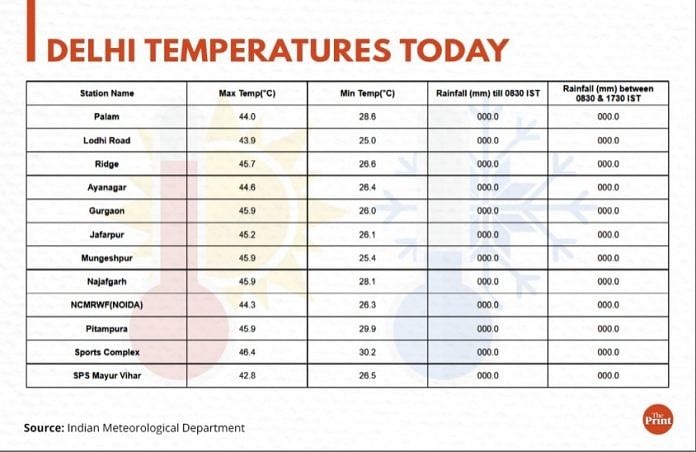New Delhi: Yamuna Sports Complex sizzled at 46.4°Celsius Saturday — the highest in the capital — while Mayur Vihar, a place that is less than 10 km away, recorded the lowest temperature in the city at 42.8°C.
As the relentless summer sun continues to scorch the country, a strange phenomenon has come to light in the national capital — the places with the highest and the lowest temperatures are within a distance of less than 10 km of one another.
The distance was even closer Thursday — the Sports Complex station in the Commonwealth Games Village recorded 46°C against 42.2°C in Mayur Vihar, which is less than 5 km away.
Incidentally, the Sports Complex station was tied with Hisar as the hottest in the country that day, Hindustan Times said in its report.
R.K. Jenamani, a scientist at Indian Meteorological Department, attributes this difference in temperatures — even within such short distances — to something called the “heat island effect”.
Also Read: India’s early heatwave sign of climate change, could be more dangerous to health, say experts
What is the heat-island effect?
According to US Environment Protection Agency, urban centers with highly concentrated man-made structures become ‘islands’ of higher temperature in comparison to other outlying areas. This happens because buildings, roads, and other infrastructure absorb and re-emit the sun’s heat more than natural landscapes such as water bodies and green covers, the website says.
This ‘heat island effect’ causes daytime temperatures in urban areas to rise up to 8 degrees higher, Jenamani said. As a result, temperatures can vary over barely 300 metres.
“If you were to put a thermometer in the middle of Lodhi Garden, you’d see it is 6-8 degrees less than some areas nearby,” Jenamani said. This, he said, was because of the dense tree cover around Lodhi Garden.
It’s for this reason that Akshardham, which is less than 4 km from Mayur Vihar, records significantly higher temperatures, even though there’s a water body — the Yamuna — nearby.
“There are no trees in the Akshardham area and the Yamuna river, which is a kilometre away, will not help with the high temperature without green cover,” Jenamani said.
Mayur Vihar’s temperatures are generally lower in comparison to the rest of the city because of the Sanjay Lake and the forest area surrounding it.
The Sanjay Lake is an artificial lake developed by Delhi Development Authority (DDA) in Trilokpurii, which adjoins Mayur Vihar II.
Early heatwave, little respite
The country is in the middle of an intense, and early, heatwave. According to the IMD, the country’s principal meteorological agency, this March was the hottest in 122 years. Temperatures in northwestern parts of the country are currently souring to 46° C and the country has already seen four heatwaves — two of those in March alone.
IMD chief Mrutyunjay Mohapatra in a conference said Saturday that conditions are unlikely to change soon — heat waves to severe heatwave conditions will likely continue over the northwest, western and central India until 1 May and gradually decrease in intensity thereafter, accompanied by thunderstorms and dust storms, because of an approaching Western disturbance.
The east will see some respite after 1 May because of thunderstorms caused by the Easterly winds from the Bay of Bengal, Mohapatra said.
(Edited by Uttara Ramaswamy)
Also Read: India endures severe heat waves — The only reason is global warming






